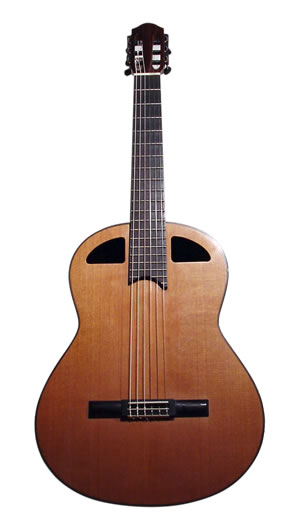
My Guitar is a 2003 Extended Lattice, Designed by Alan Chapman.
Alan Chapman has been building guitars professionally since 1973.
He is an experienced woodworking instructor with a broad understanding of small shop production techniques. His instruments are played by world-famous recitalists and students in North America and Europe.
Chapman's work is influenced by a combination of scientific discipline and a thorough understanding of the history of classical guitar design, producing a range of instruments from traditional fan braced guitars to cutting-edge graphite reenforced lattice braced guitars.
New Directions In Guitar Making
by Alan Chapman, Guitarmaker
65 Montague Road, Amherst MA 01002
413-549-6455
I appreciate the sound of traditional, fan-braced guitars. For the last twenty-five years, I designed and built traditional fan-braced guitars attempting to capture and define the warmth and beauty of that sound found in 60ís and 70ís Bream recordings. Who can resist the nuance of a vintage Hauser or Romanillos guitar or the warmth of a ë60ís Ramirez? Even so, I am increasingly drawn to the power, clarity, sustain and greater dynamic range of some newer designs.
New designs with lattice and core-box tops play louder with less effort. A player can play longer with less fatigue and include more technically demanding material in his or her repertoire. Most professionals agree the recital material of the ë90ís is much more demanding on average than a decade or more ago. Players are acquiring more new pieces and playing more chamber works with less and less time to polish and settle. Lattice and core-box guitars allow the player to bring new pieces to a higher level quicker while conserving physical resources.
Australian builder Greg Smallman, perhaps inspired by Martin x-braced guitars, created his first successful lattice-braced guitar in 1981. The lattice (picture a diagonal porch lattice) consists of eighteen interlocking braces. It is an effective and strong bracing technique which allows a guitarís top to be about one-half the thickness of a traditional top.
In my building, I recently ran a series of eighty test tops to arrive at a stable design. I now offer a lattice guitar with a traditional back (rather than a Smallman-type molded, braceless back) which gives the player a warmer experience. Any lost power is restored by reducing inertia structurally throughout.
The lattice is now a widely accepted bracing pattern which I believe will rival the popularity of traditional fan bracing. Simply building a lattice guitar is no guarantee of making a fine guitar, of course. Using the lattice is as subtle an art as any luthierie but well worth the effort.
from an article written for the Boston Classical Guitar Society newsletter

